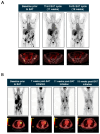Two Decades of Disease Evolution and Biomarker-Guided Clinical Decision Making in Metastatic Prostate Cancer
- PMID: 40806723
- PMCID: PMC12347661
- DOI: 10.3390/ijms26157593
Two Decades of Disease Evolution and Biomarker-Guided Clinical Decision Making in Metastatic Prostate Cancer
Abstract
Despite significant advances in prostate cancer treatment over the past two decades, metastatic castration-resistant prostate cancer (mCRPC) remains incurable. We present the case of a patient with aggressive prostate cancer diagnosed 20 years ago, underscoring the value of longitudinal genomic profiling and advanced imaging to guide clinical decisions. After multiple treatment failures, genomic analyses of tissue and liquid biopsies revealed dynamic changes in tumor biology and the emergence of resistance mechanisms, particularly AR amplification, identified with a liquid biopsy test and validated by [18F]-FDHT PET scan. This finding guided treatment with bipolar androgen therapy (BAT), which achieved a dramatic clinical response, reduced AR expression, improved symptoms, and restored sensitivity to enzalutamide. This case exemplifies the utility of serial liquid biopsies in uncovering mechanisms of tumor evolution and resistance, and the crucial role of cutting-edge diagnostics in personalized cancer treatment.
Keywords: AR amplification; bipolar androgen therapy (BAT); liquid biopsy; longitudinal genomic profiling; metastatic castration-resistant prostate cancer (mCRPC); tumor evolution.
Conflict of interest statement
The authors declare that they have no known competing financial interests or personal relationships that could have appeared to influence the work reported in this paper.
Figures



Similar articles
-
rechARge: a randomized phase III trial of the androgen receptor ligand-directed degrader, BMS-986365, vs investigator's choice in patients with mCRPC.Future Oncol. 2025 Jun;21(14):1771-1777. doi: 10.1080/14796694.2025.2502318. Epub 2025 Jun 2. Future Oncol. 2025. PMID: 40455815 Free PMC article.
-
Clinical Context Shapes the Relationship between Genomic Alterations and Response to AR Inhibitors and Chemotherapy in Metastatic Prostate Cancer.Clin Cancer Res. 2025 Jul 1;31(13):2824-2838. doi: 10.1158/1078-0432.CCR-24-1812. Clin Cancer Res. 2025. PMID: 40227200 Free PMC article.
-
Olaparib Monotherapy or in Combination with Abiraterone for the Treatment of Patients with Metastatic Castration-Resistant Prostate Cancer (mCRPC) and a BRCA Mutation.Target Oncol. 2025 May;20(3):445-466. doi: 10.1007/s11523-025-01146-4. Epub 2025 May 21. Target Oncol. 2025. PMID: 40397306 Free PMC article. Review.
-
Circulating Biomarkers Predictive of Treatment Response in Patients with Hormone-sensitive or Castration-resistant Metastatic Prostate Cancer: A Systematic Review.Eur Urol Oncol. 2024 Dec;7(6):1228-1245. doi: 10.1016/j.euo.2024.05.003. Epub 2024 May 31. Eur Urol Oncol. 2024. PMID: 38824003
-
Quantitative Analysis of Serial Positron Emission Tomography Imaging in Men with Metastatic Castration-resistant Prostate Cancer Treated with Enzalutamide.Eur Urol Oncol. 2024 Aug;7(4):735-741. doi: 10.1016/j.euo.2023.09.010. Epub 2023 Oct 17. Eur Urol Oncol. 2024. PMID: 37858437 Free PMC article. Clinical Trial.
References
-
- Banerjee S., Booth C.M., Bruera E., Buchler M.W., Drilon A., Fry T.J., Ghobrial I.M., Gianni L., Jain R.K., Kroemer G., et al. Two decades of advances in clinical oncology-lessons learned and future directions. Nat. Rev. Clin. Oncol. 2024;21:771–780. doi: 10.1038/s41571-024-00945-4. - DOI - PMC - PubMed
-
- Freedland S.J., Davis M., Epstein A.J., Arondekar B., Ivanova J.I. Real-world treatment patterns and overall survival among men with Metastatic Castration-Resistant Prostate Cancer (mCRPC) in the US Medicare population. Prostate Cancer Prostatic Dis. 2024;27:327–333. doi: 10.1038/s41391-023-00725-8. - DOI - PMC - PubMed
Publication types
LinkOut - more resources
Full Text Sources
Research Materials
Miscellaneous

